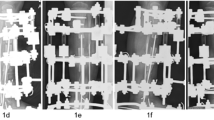Abstract
The study presented here is a pilot study in five patients with unstable thoracolumbar spine fractures treated with transpedicular OP-1 transplantation, short segment instrumentation and posterolateral fusion. Recombinant bone morphogenetic protein-7 in combination with a collagen carrier, also referred to as OP-1, has demonstrated ability to induce healing in long-bone segmental defects in dogs, rabbits and monkeys and to induce successful posterolateral spinal fusion in dogs without need for autogenous bone graft. Furthermore OP-1 has been demonstrated to be effective as a bone graft substitute when performing the PLIF maneuver in a sheep model. Five patients with single-level unstable burst fracture and no neurological impairment were treated with intracorporal OP-1 transplantation, posterior fixation (USS) and posterolateral fusion. One patient with osteomalacia and an L2 burst fracture had an additional intracorporal transplantation performed proximal to the instrumented segment, i.e. OP-1 into T 12 and autogenous bone into T 11. Follow-up time was 12–18 months. On serial radiographs, Cobb and kyphotic angles, as well as anterior, middle and posterior column heights, were measured. Serial CT scans were performed to determine the bone mineral density at fracture level.
In one case, radiographic and CT evaluation after 3 and 6 months showed severe resorption at the site of transplantation, but after 12 months, new bone had started to fill in at the area of resorption. In all cases there was loss of correction with regard to anterior and middle column height and sagittal balance at the latest follow-up. These preliminary results regarding OP-1 as a bone graft substitute and stimulator of new bone formation have been disappointing, as the OP-1 device in this study was not capable of inducing an early sufficient structural bone support. There are indications to suggest that OP-1 application to a fracture site in humans might result in detrimental enhanced bone resorption as a primary event.
Similar content being viewed by others
Author information
Authors and Affiliations
Additional information
Received: 13 February 1999 Revised: 4 August 1999 Accepted: 18 August 1999
Rights and permissions
About this article
Cite this article
Laursen, M., Høy, K., Hansen, E. et al. Recombinant bone morphogenetic protein-7 as an intracorporal bone growth stimulator in unstable thoracolumbar burst fractures in humans: preliminary results. E Spine J 8, 485–490 (1999). https://doi.org/10.1007/s005860050210
Issue Date:
DOI: https://doi.org/10.1007/s005860050210




